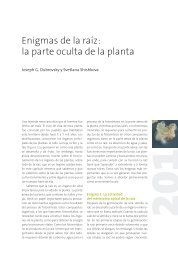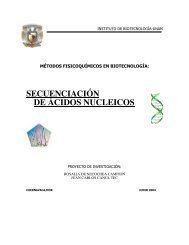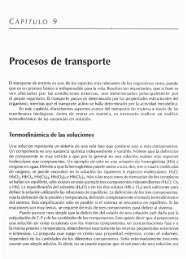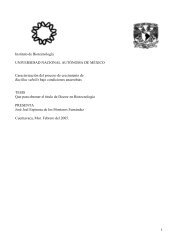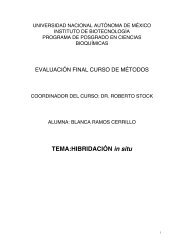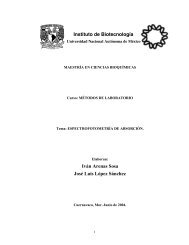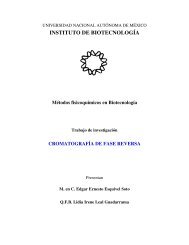Interaction of the virulence protein VirF of Agrobacterium ...
Interaction of the virulence protein VirF of Agrobacterium ...
Interaction of the virulence protein VirF of Agrobacterium ...
Create successful ePaper yourself
Turn your PDF publications into a flip-book with our unique Google optimized e-Paper software.
Figure 1<br />
Alignment <strong>of</strong> <strong>the</strong> deduced amino acid<br />
sequence for ASK1, ASK2, and ASK10. The<br />
GenBank accession numbers are,<br />
respectively, ATU97020, ATU97021, and<br />
AF132729. Similar or identical amino acids<br />
are placed in a box; gaps in <strong>the</strong> alignment<br />
are indicated by dots.<br />
Brief Communication 259<br />
ASK <strong>protein</strong>s, are subunits <strong>of</strong> a class <strong>of</strong> E3 ubiquitin used <strong>the</strong> mutant <strong>VirF</strong> plasmids in two-hybrid assays with<br />
ligases called SCF (Skp1-Cdc53-F box <strong>protein</strong>) com- <strong>the</strong> ASK <strong>protein</strong>s. In such assays no interaction with ASK1,<br />
plexes. These complexes target specific <strong>protein</strong>s for prote- ASK2, or ASK10 was any longer observed, nei<strong>the</strong>r for <strong>the</strong><br />
olysis and thus play an important regulatory role in pro- <strong>VirF</strong>�F-box nor for <strong>the</strong> <strong>VirF</strong>(LP→AA) <strong>protein</strong>, in contrast<br />
cesses such as <strong>the</strong> cell cycle [12–15]. SCF complexes with <strong>the</strong> results for <strong>the</strong> full-length <strong>VirF</strong> <strong>protein</strong> (Figure<br />
consist <strong>of</strong> a scaffold <strong>protein</strong>, Cdc53p or Cullin, to which 3a,b). These results indicate that <strong>the</strong> binding to ASK1,<br />
is bound Cdc34p, which is an ubiquitin-conjugating en- ASK2, and ASK10 is mediated by <strong>the</strong> F box present in<br />
zyme; <strong>the</strong> Rbx1 <strong>protein</strong>, which assists in <strong>the</strong> recruitment<br />
and activation <strong>of</strong> Cdc34p; and Skp1p. This latter <strong>protein</strong><br />
<strong>VirF</strong>.<br />
may in turn recruit a variety <strong>of</strong> so-called F box <strong>protein</strong>s<br />
by binding directly to <strong>the</strong>ir F box. The F box <strong>protein</strong>s<br />
act as receptors, which attract specific <strong>protein</strong>s to <strong>the</strong> SCF<br />
complex for ubiquitination and subsequent proteolysis.<br />
The binding <strong>of</strong> <strong>VirF</strong> to <strong>the</strong> ASK <strong>protein</strong>s suggested that<br />
<strong>VirF</strong> may also contain an F box motif. Comparison <strong>of</strong><br />
<strong>VirF</strong> with F box–containing <strong>protein</strong>s from various species<br />
[12] indeed revealed <strong>the</strong> presence <strong>of</strong> <strong>the</strong> conserved leucine<br />
and proline residues (amino acids 26, 27, and 38) in<br />
<strong>VirF</strong>. Additionally, <strong>the</strong> presence <strong>of</strong> an F box in <strong>VirF</strong> was<br />
confirmed by <strong>the</strong> Pr<strong>of</strong>ileScan program for amino acid positions<br />
20 to 42: KTELLNLPDHVLTEVAKRLATNN.<br />
To find out whe<strong>the</strong>r <strong>the</strong> presence <strong>of</strong> an F box is essential<br />
for <strong>the</strong> functioning <strong>of</strong> <strong>VirF</strong> in tumorigenesis, we intro-<br />
duced <strong>the</strong> <strong>VirF</strong>(LP→AA) mutant allele into an Agrobacter-<br />
ium virF deletion mutant. Virulence assays showed that <strong>the</strong><br />
<strong>Agrobacterium</strong> strains producing <strong>the</strong> mutant form <strong>of</strong> <strong>VirF</strong><br />
instead <strong>of</strong> wild-type <strong>VirF</strong> were attenuated in <strong>virulence</strong><br />
on Nicotiana glauca plants, as were virF deletion mutants.<br />
Figure 3c shows an example <strong>of</strong> a stem infection. Thus,<br />
<strong>the</strong> presence <strong>of</strong> a functional F box seems essential for <strong>the</strong><br />
biological function <strong>of</strong> <strong>VirF</strong>. The presence <strong>of</strong> a functional<br />
F box in <strong>the</strong> A. tumefaciens <strong>VirF</strong> <strong>protein</strong> is surprising. So<br />
far F box <strong>protein</strong>s have only been found in eukaryotic<br />
organisms such as yeast, humans, plants, and fungi as well<br />
We created an N-terminal deletion, including <strong>the</strong> deletion as in human viruses [12–15], but not in prokaryotes. <strong>VirF</strong><br />
<strong>of</strong> <strong>the</strong> F box, to confirm that <strong>VirF</strong> binds ASK1, ASK2, is <strong>the</strong> first F box <strong>protein</strong> identified in bacteria. The finding<br />
and ASK10 via its F box. For <strong>the</strong> same reason, we replaced <strong>of</strong> a gene for an F box <strong>protein</strong> on <strong>the</strong> Ti plasmid <strong>of</strong> A.<br />
<strong>the</strong> two most-conserved amino acids <strong>of</strong> <strong>the</strong> F box, leucine tumefaciens underscores <strong>the</strong> remarkable gene content <strong>of</strong><br />
26 and proline 27, by alanine. Previous studies have shown this genetic element, which includes not only typically<br />
that mutation <strong>of</strong> <strong>the</strong> conserved leucine and proline resi- eukaryotic genes with eukaryotic expression signals but<br />
dues in <strong>the</strong> F box <strong>protein</strong> Cdc4p results in decreased also prokaryotic genes coding for <strong>protein</strong>s with eukaryotic<br />
binding <strong>of</strong> Skp1p [12] and that mutation <strong>of</strong> <strong>the</strong> conserved features such as <strong>the</strong> nuclear localization sequence (VirD2,<br />
leucine residue in <strong>the</strong> F box <strong>protein</strong> SCON2 leads to a VirE2) and <strong>the</strong> F box (<strong>VirF</strong>). Although no direct evidence<br />
loss <strong>of</strong> function [16]. The YPB2 yeast strain was trans- has been obtained so far, it seems likely that some <strong>of</strong> this<br />
formed with ei<strong>the</strong>r pBI770-<strong>VirF</strong>�F-box or pBI770-Virgenetic material was introduced into this bacterium by<br />
F(LP→AA) alone (data not shown) or in combination with<br />
<strong>the</strong> empty vector pBI771 (Figure 3). As expected, <strong>the</strong><br />
horizontal gene transfer from an eukaryotic organism.<br />
Gal4BD-<strong>VirF</strong>�F-box and Gal4BD-<strong>VirF</strong>(LP→AA) fusion Proteins with similarity to <strong>the</strong> <strong>VirF</strong> <strong>protein</strong> described<br />
<strong>protein</strong>s could not activate transcription <strong>of</strong> <strong>the</strong> reporter above are encoded by o<strong>the</strong>r types <strong>of</strong> Ti plasmids as well<br />
genes in yeast, as <strong>the</strong> lack <strong>of</strong> lacZ or His3 expression as by <strong>the</strong> Ri plasmid <strong>of</strong> <strong>Agrobacterium</strong> rhizogenes ([17], Genindicated.<br />
Western blot analysis with <strong>VirF</strong> polyclonal anti- Bank accession numbers AF034769 and AP002086). A<br />
bodies showed <strong>the</strong> expression <strong>of</strong> <strong>the</strong> Gal4BD-<strong>VirF</strong>�F- comparison <strong>of</strong> <strong>the</strong> F box regions revealed <strong>the</strong> presence<br />
box and Gal4BD-<strong>VirF</strong>(LP→AA) fusion <strong>protein</strong>s in <strong>the</strong> <strong>of</strong> <strong>the</strong> conserved leucine and proline residues in <strong>the</strong> <strong>VirF</strong><br />
YPB2 yeast strain (data not shown). As <strong>the</strong> control experi- homologs encoded by <strong>the</strong> A. vitis Ti plasmid and <strong>the</strong> Ri<br />
ments did not show unexpected results, we subsequently<br />
plasmid. We have shown previously that <strong>the</strong> <strong>VirF</strong> homolog




